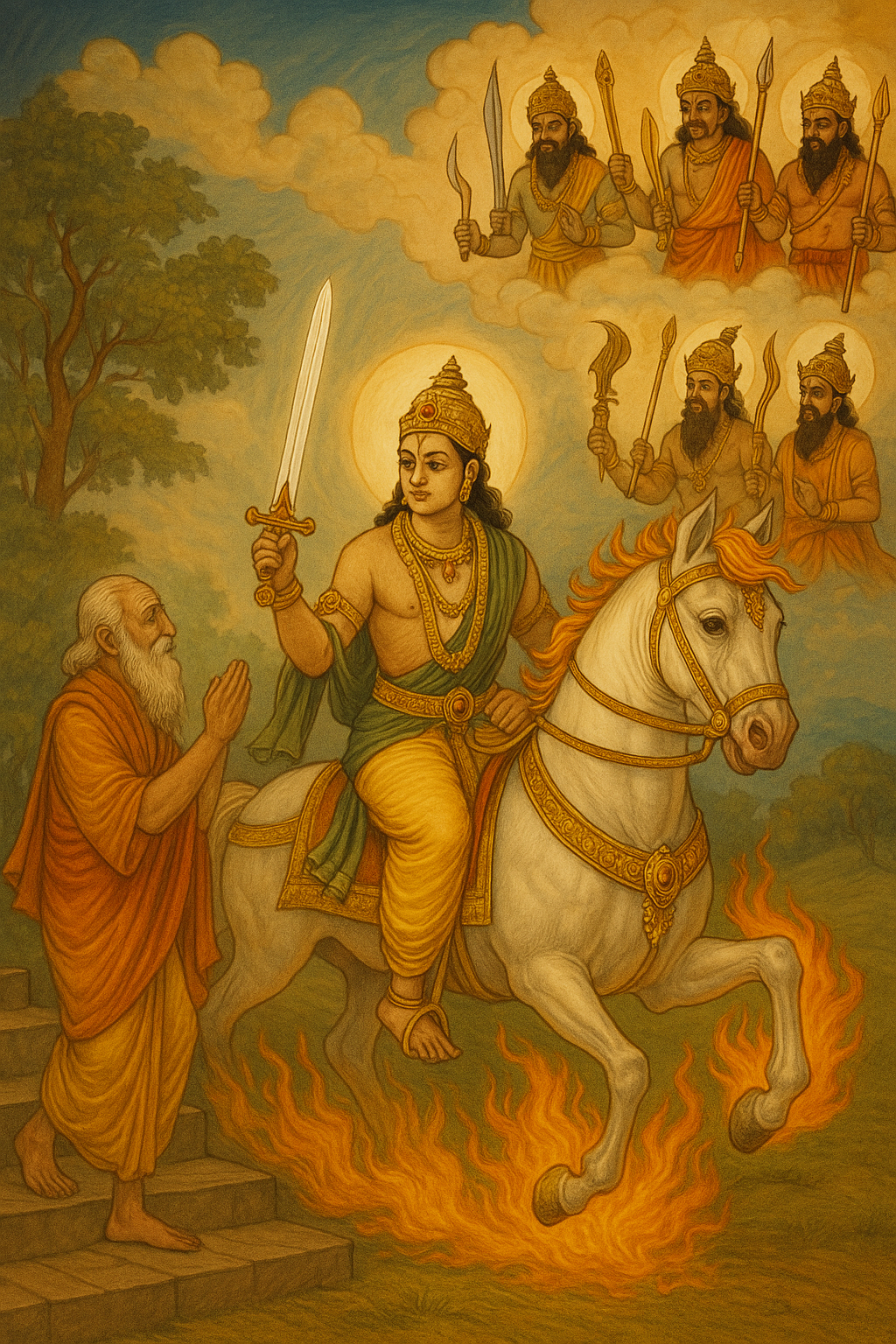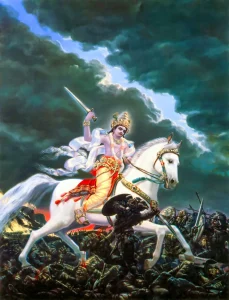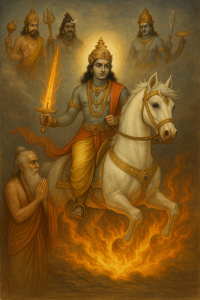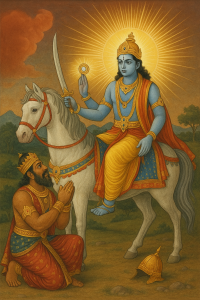Divine Promise to Restore Dharma
As the dark shadow of Kali-yuga thickened, adharma (irreligion) spread like wildfire across the world. The hearts of men grew hard. Truth was mocked, the Vedas were abandoned, cows and sages were dishonored, and royal courts became dens of deceit and tyranny. The earth, overwhelmed by the burden of sin and injustice, wept and prayed for divine intervention.
In response to her anguished cries, the compassionate Lord Nārāyaṇa made a solemn vow. One final time, He would descend to annihilate evil, protect the innocent, and restore the eternal path of righteousness. He would appear as Kalki, the blazing warrior, the final avatāra in this age of iron and chaos.
Śambhala Village: The Chosen Place
In the holy land of Bhārata, there existed a secluded and sanctified village called Śambhala. Surrounded by sacred rivers and whispering forests, it remained a haven of dharma amidst a collapsing world.
There, a saintly brāhmaṇa named Viṣṇuyaśā resided. Renowned for his purity, austerity, and unwavering devotion to Lord Viṣṇu, he lived with his noble wife Satyavatī, also known as Sumati. Gentle in speech and radiant with virtue, she matched her husband in spiritual stature.
Together, they lived a life of simplicity and devotion. Daily they performed sacred fire sacrifices, honored guests with humility, and worshipped the Lord with full-hearted bhakti. Their home was a lamp of righteousness flickering in a world lost in darkness.
The Auspicious Birth of the Avatāra
On a most auspicious Dvādaśī day, when the constellation Revati shone in the sky, Satyavatī gave birth to a divine child. As she delivered the Lord, a golden radiance enveloped the earth. Celestial flowers rained from the sky. The demigods gazed in silent ecstasy. The trees blossomed, waters sparkled, and a transcendental peace settled over Śambhala.
The child was dark like a monsoon cloud. His eyes glowed with the brilliance of two rising suns. Auspicious marks such as the śaṅkha (conch), cakra (disc), and lotus adorned His hands and chest. His feet bore the symbols of Viṣṇu—flag, thunderbolt, and goad.
Sages and astrologers, drawn by divine omens, arrived to witness this marvel. Overwhelmed by the signs, they exclaimed:
“This child shall destroy the demonic and reestablish Sanātana-dharma. He will shine with the effulgence of ten thousand suns. Truly, He is the Yuga-avatāra—the Lord’s final descent in this age.”
Early Signs of Divinity
From the earliest days, the divine nature of Kalki was apparent. He effortlessly mastered the Vedas, Smṛtis, and martial arts within a few years. His conduct was filled with dignity, compassion, and truth. His strength surpassed the strongest warriors, and yet he spoke with gentle wisdom that melted hearts.
Though still a child, Kalki radiated both fearlessness and humility. Villagers were astonished by His character and sought His darśana. Viṣṇuyaśā and Satyavatī nurtured Him with great love, guiding Him in dharma and spiritual discipline.
The child was given the name Kalki, meaning “the destroyer of impurity,” for He was destined to cleanse the world of the darkness of Kali.
Lessons to Be Learned:
- The Lord always descends when dharma declines, especially during times of extreme moral and spiritual crisis.
- The birth of an avatāra is never ordinary—it is accompanied by celestial signs, divine beauty, and transcendental joy.
- Even the Supreme Lord accepts the role of a child to teach by example the virtues of humility, discipline, and devotion.
- As declared in the Bhagavad-gītā (4.8): paritrāṇāya sādhūnāṁ vināśāya ca duṣkṛtām
dharma-saṁsthāpanārthāya sambhavāmi yuge yuge
“To deliver the pious, to annihilate the miscreants, and to reestablish the principles of religion, I appear millennium after millennium.”
Origin of the Story: Kalki Purāṇa, Chapters 2–3, describing the divine birth of Lord Kalki in Śambhala.



